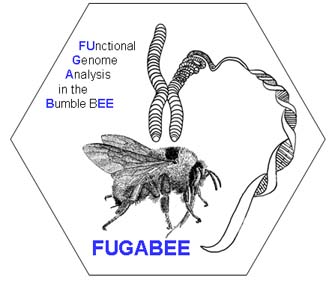
Contact
Dr. H. Michael G. Lattorff
phone: +49-(0)345-5526389
fax: +49-(0)345-5527264
lattorff@zoologie.uni-halle.de
room 129b
Hoher Weg 4
06099 Halle
FUGABEE
Functional analysis of disease resistance genes in bumble bees (Bombus terrestris)

Although many may consider the honeybee Apis mellifera as the only agriculturally used beneficial insect, it becomes very clear that although Apis is good for honey production it is clearly out competed by bumblebees when it comes to pollination services. During the past decades bumblebees (e.g. Bombus terrestris) have gained a major role for pollination purposes in greenhouses and in the field. Various companies commercially produce bumblebee colonies for pollination in large numbers and the market has developed into a multimillion dollar enterprise in Western Europe. The rearing of bumblebees throughout the year in indoor breeding facilities is now routine practice, which is the essence for on time delivery of bumblebees around the globe. Although the breeding technique is well established, the producers are often hit by diseases eradicating their breeding lines. These losses are usually replenished by captures of wild queens in Turkey, causing various concerns also from a biodiversity perspective. Clearly, disease resistant stock would overcome these problems and the need to repeatedly restock the breeding lines. However, systematic breeding in bumblebees is only incipient at best. The discipline may however profit from a jump start if the results from genome sequencing effort for the honeybee can be utilized for the system bumblebee.
The project presented here will focus on identifying colonies that show a general increase in immune response, which is often mediated by antimicrobial proteins as well as the number of hemocytes and the ability of nodule formation (Howard et al. 1998). Moreover the level of prophenol- and phenoloxidase in the hemolymph (Hultmark 2003) will be determined. We also will screen for proteins relevant in the immune competence of the bees as known from the honeybee and other solitary insects. Differences between colonies showing high immune response will be compared to colonies with low immune response. This will lead us to identify the responsible mechanisms at the colony level down to the level of the genes responsible for these differences. A huge battery of resources available for the bumble bee (mass rearing of colonies, instrumental insemination for artificial crosses, large number of microsatellites currently developed, BAC-library and the haplo-diploid system) will facilitate this project.
The major goal is to identify the mechanisms of immune competence in bumble bees and to use this knowledge to develop tools for marker-assisted selection programs which most likely will be converted into a commercially available tool in bumble bee breeding.
Nosema is a big problem for bumblebee rearing. Infections may cause the total breakdown of whole breeding lines, as seen in the mid-1990’s in the North American B. occidentalis. Stocks are then re-established by wild-caught queens, which may introduce new parasites to the breeding stocks. The North American Nosema infection most likely arose from such an introduction via wild-caught individuals. A different Nosema species parasitizes the honeybees midgut can be treated using the antibiotic fumagillin. Recent studies have shown that fumagillin is not effective against N. bombi, which raises the question for different treatments.



